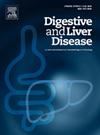Incidence of clinical outcomes in patients with MASLD and long-term follow up: results from a single center cohort study
IF 4
3区 医学
Q1 GASTROENTEROLOGY & HEPATOLOGY
引用次数: 0
Abstract
Introduction
The natural history of MASLD results from environmental and genetic factors, impacting hepatic and extrahepatic outcomes. This study aims to elucidate the incidence of clinical outcomes, and the impact of non-invasive tests (NITs) and genetic factors.
Materials and methods
A retrospective study was conducted on patients undergoing vibration-controlled transient elastography (VCTE) for liver stiffness measurement (LSM), with at least 6 months follow-up. Other etiologies than MASLD, previous decompensation or hepatocarcinoma (HCC) were excluded. Significant liver fibrosis was defined by LSM≥8 Kpa, clinically significant portal hypertension (CSPH) by LSM≥25 Kpa. Primary endpoints included incidence of major adverse liver outcomes (MALOs): cirrhosis, liver decompensation (ascites, encephalopathy, variceal bleeding), HCC and liver transplant.
Results
504 patients were selected (61.7% males, median age 59 years [IQR 50.0-67.0]), with a median follow-up of 45.5 months [9.5-94.5]. Median LSM was 6.4 Kpa [5.0-9.0], 21% had PNPLA3 GG. Overall, 11.3% experienced MALOs (33.3% liver decompensation), 2.6% died (46.2% liver-related events). Significant fibrosis increased MALOs incidence (log rank p<0.0001, HR14.4, 95%CI 5.5-13.3). CSPH raised liver decompensation occurrence (p=0.007, HR 6.1, 95%CI 3.3-22.4). Type 2 diabetes (T2D) and PNPLA3 GG increased MALOs incidence (p<0.001, HR 3.8, 95%CI 2.03-6.2; p=0.004, HR 2.3, 95%CI 1.38-5.61). Obese/overweight patients had higher MALOs incidence than lean individuals (p=0.008, HR 2.67, 95% Cl 1.31-3.94). Multivariable Cox regression analysis showed that significant fibrosis by LSM was independently associated with MALOs (aHR 18.5, p<0.0001, 95%Cl 5.65-60.7).
Conclusions
Overweight/obesity and T2D increase incidence of MALOs. LSM by VCTE and PNPLA3 genotyping are useful tools for risk stratification.
求助全文
约1分钟内获得全文
求助全文
来源期刊

Digestive and Liver Disease
医学-胃肠肝病学
CiteScore
6.10
自引率
2.20%
发文量
632
审稿时长
19 days
期刊介绍:
Digestive and Liver Disease is an international journal of Gastroenterology and Hepatology. It is the official journal of Italian Association for the Study of the Liver (AISF); Italian Association for the Study of the Pancreas (AISP); Italian Association for Digestive Endoscopy (SIED); Italian Association for Hospital Gastroenterologists and Digestive Endoscopists (AIGO); Italian Society of Gastroenterology (SIGE); Italian Society of Pediatric Gastroenterology and Hepatology (SIGENP) and Italian Group for the Study of Inflammatory Bowel Disease (IG-IBD).
Digestive and Liver Disease publishes papers on basic and clinical research in the field of gastroenterology and hepatology.
Contributions consist of:
Original Papers
Correspondence to the Editor
Editorials, Reviews and Special Articles
Progress Reports
Image of the Month
Congress Proceedings
Symposia and Mini-symposia.
 求助内容:
求助内容: 应助结果提醒方式:
应助结果提醒方式:


